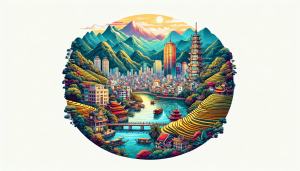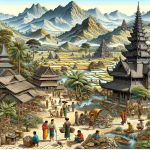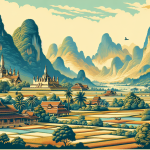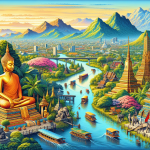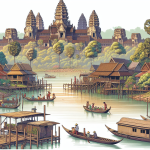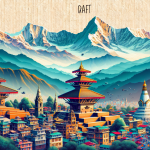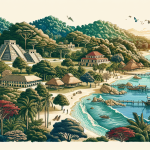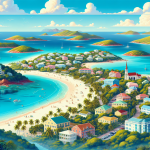Discovering the Wonders of Vietnam: An Unforgettable Journey
Vietnam, a land of breathtaking landscapes, rich history, and vibrant culture, is a destination that promises an unforgettable journey for any traveler. From the bustling streets of Hanoi to the serene waters of Ha Long Bay, Vietnam offers a unique blend of ancient traditions and modern attractions. In this comprehensive guide, we will explore the many facets of Vietnam, providing you with insights and tips to make the most of your visit. Whether you are a history enthusiast, a nature lover, or a culinary explorer, Vietnam has something special to offer. So, pack your bags and get ready for an adventure like no other as we delve into the wonders of Vietnam.
Unveiling the Charms of Hanoi
A Glimpse into Hanoi’s History
Hanoi, the capital city of Vietnam, is a place where history comes alive. The city’s Old Quarter, with its narrow streets and colonial architecture, is a testament to its rich past. Here, you can wander through bustling markets, visit ancient temples, and explore historic sites. One must-visit location is the Ho Chi Minh Mausoleum, where you can pay your respects to the revered leader. Nearby, the One Pillar Pagoda, an iconic symbol of Hanoi, offers a serene escape amidst the urban hustle.
The Culinary Delights of Hanoi
Hanoi is also a food lover’s paradise. The city’s street food scene is legendary, offering a variety of flavors that will tantalize your taste buds. Don’t miss the chance to savor Pho, a traditional Vietnamese noodle soup that has gained international fame. Another must-try dish is Bun Cha, a flavorful combination of grilled pork, noodles, and fresh herbs. For a unique experience, visit one of Hanoi’s many egg coffee cafes, where you can enjoy a creamy and rich coffee topped with a frothy egg foam.
Exploring the Natural Beauty of Ha Long Bay
The Majesty of Ha Long Bay
Ha Long Bay, a UNESCO World Heritage Site, is a natural wonder that should be on every traveler’s bucket list. Located in northeastern Vietnam, this stunning bay is known for its emerald waters and thousands of limestone karsts and isles. Embarking on a Ha Long Bay cruise is the best way to experience its beauty. You can explore hidden caves, visit floating villages, and even try your hand at kayaking. The mesmerizing sunsets over the bay are an unforgettable sight that will leave you in awe.
Adventure Activities in Ha Long Bay
For adventure enthusiasts, Ha Long Bay offers a range of activities. Rock climbing on the limestone cliffs is a popular choice for thrill-seekers, providing a unique perspective of the bay’s topography. If you prefer water activities, snorkeling and scuba diving allow you to discover the vibrant marine life beneath the surface. Another exciting option is night squid fishing, where you can join local fishermen and experience the thrill of catching squid under the moonlit sky.
Immersing in the Culture of Hoi An
The Timeless Beauty of Hoi An
Hoi An, a charming town on Vietnam’s central coast, is a place where time seems to stand still. Known for its well-preserved ancient town, Hoi An offers a glimpse into Vietnam’s rich cultural heritage. The narrow streets are lined with yellow-walled houses, lantern-lit cafes, and traditional shops. A stroll through the ancient town at night, when the lanterns illuminate the streets, is a magical experience that transports you to another era.
Tailoring and Craftsmanship in Hoi An
Hoi An is also famous for its tailoring and craftsmanship. The town is dotted with tailor shops where you can have custom-made clothing crafted to your specifications. From suits to dresses, the skilled tailors of Hoi An can create high-quality garments in a matter of days. Additionally, you can explore the local handicraft villages to witness traditional techniques of pottery, lantern-making, and silk weaving. These experiences provide a deeper understanding of Vietnam’s artisanal traditions.
Discovering the History of Hue
The Imperial City of Hue
Hue, located in central Vietnam, was once the imperial capital of the Nguyen Dynasty. The city’s most iconic landmark is the Imperial City, a sprawling complex of palaces, temples, and gardens. Walking through the historic gates and exploring the ancient structures, you can imagine the grandeur of the past. Key attractions within the Imperial City include the Forbidden Purple City, the Thai Hoa Palace, and the Royal Tombs. Each site offers a glimpse into the royal history and architectural splendor of Hue.
The Perfume River
The Perfume River, which flows through Hue, adds to the city’s charm. Taking a boat cruise along the river is a serene way to explore the area. The riverbanks are dotted with pagodas, temples, and traditional villages. One notable site is the Thien Mu Pagoda, a historic temple that stands majestically by the river. As you drift along the Perfume River, you’ll be captivated by the scenic beauty and the sense of tranquility that envelops the area.
The Vibrant Streets of Ho Chi Minh City
The Dynamic Energy of Saigon
Ho Chi Minh City, also known as Saigon, is Vietnam’s largest city and a bustling metropolis that never sleeps. The city’s vibrant energy is evident in its busy streets, bustling markets, and modern skyscrapers. One of the best ways to experience the city’s dynamic atmosphere is by exploring Ben Thanh Market, where you can find everything from fresh produce to handicrafts. The market is a sensory overload, with its vibrant colors, enticing aromas, and lively sounds.
Historical Sites in Ho Chi Minh City
Ho Chi Minh City is also home to several significant historical sites. The War Remnants Museum provides a sobering look at the Vietnam War, with exhibits that detail the conflict’s impact on the country. Another must-visit site is the Cu Chi Tunnels, an extensive network of underground tunnels used during the war. Exploring the tunnels gives you a sense of the ingenuity and resilience of the Vietnamese people. Additionally, the Notre-Dame Cathedral Basilica of Saigon and the Saigon Central Post Office are architectural gems that reflect the city’s colonial past.
The Enchanting Mekong Delta
The Life-Giving Waters of the Mekong Delta
The Mekong Delta, often referred to as the “Rice Bowl” of Vietnam, is a vast network of rivers, swamps, and islands in the southern part of the country. The delta is known for its fertile land and abundant waterways, which support a thriving agricultural industry. Exploring the Mekong Delta offers a glimpse into the traditional way of life in rural Vietnam. You can take a boat tour through the winding canals, visit local farms, and sample fresh tropical fruits. The floating markets, where vendors sell their goods from boats, are a unique and vibrant sight.
Cultural Experiences in the Mekong Delta
In addition to its natural beauty, the Mekong Delta is rich in cultural experiences. You can visit traditional craft villages where artisans produce items such as coconut candy, rice paper, and pottery. These villages offer an opportunity to learn about local craftsmanship and support the livelihoods of the artisans. Another highlight is the Cai Rang Floating Market, one of the largest in the delta. Here, you can witness the bustling trade and vibrant atmosphere as boats filled with fruits, vegetables, and other goods navigate the waterways.
The Pristine Beaches of Phu Quoc
The Tropical Paradise of Phu Quoc
Phu Quoc, an island located in the Gulf of Thailand, is Vietnam’s largest island and a tropical paradise. Known for its white-sand beaches, crystal-clear waters, and lush landscapes, Phu Quoc is a perfect destination for relaxation and adventure. The island’s most famous beach, Long Beach, stretches for miles and offers a serene setting for sunbathing and swimming. For a more secluded experience, visit Sao Beach, where the soft sand and turquoise waters create a picture-perfect scene.
Activities and Attractions in Phu Quoc
Phu Quoc offers a range of activities for nature lovers and adventure seekers. Snorkeling and diving are popular options, allowing you to explore the vibrant coral reefs and marine life. The Phu Quoc National Park is another highlight, offering hiking trails through dense forests and opportunities for wildlife spotting. Additionally, the island is known for its production of fish sauce and pepper, and you can visit local farms to learn about these traditional industries. A visit to the Vinpearl Safari and Vinpearl Land amusement park is also a great option for families.
The Mystical Landscapes of Sapa
The Terraced Rice Fields of Sapa
Sapa, located in the northern mountains of Vietnam, is renowned for its stunning terraced rice fields and ethnic minority communities. The terraced fields, which change colors with the seasons, create a breathtaking landscape that is a photographer’s dream. Trekking through the hills and valleys of Sapa allows you to immerse yourself in the natural beauty and experience the traditional way of life of the local people. The Muong Hoa Valley is a popular trekking destination, offering panoramic views of the terraced fields and the surrounding mountains.
Cultural Encounters in Sapa
Sapa is home to several ethnic minority groups, including the Hmong, Dao, and Tay people. Visiting the local villages provides an opportunity to learn about their unique customs, traditions, and crafts. You can stay in a homestay with a local family, participate in traditional activities, and enjoy home-cooked meals. The Sapa Market is another cultural highlight, where you can see ethnic minority women in their colorful traditional attire selling handicrafts, textiles, and fresh produce. These cultural encounters offer a deeper understanding of Vietnam’s diverse heritage.
The Ancient Temples of My Son
The Historical Significance of My Son
My Son, located in central Vietnam, is an ancient temple complex that dates back to the Champa Kingdom. The site, a UNESCO World Heritage Site, consists of a series of Hindu temples and towers set amidst lush greenery. My Son was once a religious and cultural center, and its ruins provide a glimpse into the architectural and artistic achievements of the Champa civilization. Exploring the site, you can marvel at the intricate carvings, red-brick structures, and the sense of history that permeates the area.
Visiting My Son
Visiting My Son is a journey back in time. The best way to explore the site is by taking a guided tour, which provides insights into the history and significance of the temples. The early morning is the ideal time to visit, as the soft light and fewer crowds create a peaceful atmosphere. Some tours also include a traditional Cham dance performance, adding a cultural dimension to the experience. As you wander through the ancient ruins, you’ll be transported to a bygone era and gain a deeper appreciation for Vietnam’s rich heritage.
The Breathtaking Caves of Phong Nha-Ke Bang
The Natural Wonders of Phong Nha-Ke Bang
Phong Nha-Ke Bang National Park, a UNESCO World Heritage Site in central Vietnam, is home to some of the most spectacular caves in the world. The park’s karst landscape, formed over millions of years, is dotted with limestone peaks, underground rivers, and vast cave systems. The Phong Nha Cave and Paradise Cave are among the most famous, offering awe-inspiring formations and underground chambers. Exploring these caves is a thrilling adventure that showcases the natural beauty and geological wonders of Vietnam.
Adventure Activities in Phong Nha-Ke Bang
Phong Nha-Ke Bang is also a haven for adventure enthusiasts. In addition to cave exploration, you can embark on trekking and biking adventures through the park’s rugged terrain. The Son Doong Cave, the largest cave in the world, is a bucket-list destination for intrepid travelers. Although the expedition to Son Doong is challenging and requires a high level of fitness, the reward is an otherworldly experience that few have witnessed. For a more accessible adventure, the Dark Cave offers zip-lining, kayaking, and mud-bathing activities that are fun for all ages.
Practical Tips for Traveling in Vietnam
Best Time to Visit Vietnam
Vietnam’s climate varies significantly from north to south, so the best time to visit depends on your itinerary. Generally, the months of November to April are ideal for traveling, as the weather is cooler and drier. The north experiences a distinct winter season, with cooler temperatures from December to February. The central and southern regions have a more tropical climate, with hot and humid conditions year-round. If you plan to visit multiple regions, consider the weather patterns and pack accordingly.
Visa and Travel Requirements
Most travelers will need a visa to enter Vietnam. You can apply for a visa on arrival or obtain an e-visa before your trip. Ensure that your passport is valid for at least six months from your date of entry. It’s also a good idea to check for any vaccination requirements and consider travel insurance for added protection. When traveling within Vietnam, domestic flights, trains, and buses are convenient options for getting around. Booking transportation in advance can save you time and ensure a smooth journey.
Cultural Etiquette and Respect
Vietnamese culture places a strong emphasis on respect and courtesy. When visiting temples and religious sites, dress modestly and remove your shoes before entering. It’s also polite to greet others with a slight bow or nod. Learning a few basic phrases in Vietnamese, such as “Xin chào” (Hello) and “Cảm ơn” (Thank you), can go a long way in showing respect and building rapport with locals. Be mindful of cultural differences and always ask for permission before taking photos of people, especially in rural areas.
Conclusion
Vietnam is a land of diverse landscapes, rich history, and vibrant culture, offering an array of experiences for travelers. From the historic streets of Hanoi and the natural beauty of Ha Long Bay to the cultural heritage of Hoi An and the bustling energy of Ho Chi Minh City, Vietnam captivates the senses and leaves a lasting impression. Whether you’re exploring ancient temples, savoring delicious cuisine, or embarking on thrilling adventures, Vietnam promises an unforgettable journey. As you plan your trip, consider the tips and insights provided in this guide to make the most of your Vietnamese adventure. Embrace the beauty, culture, and warmth of Vietnam, and create memories that will stay with you long after you’ve returned home.
For more information and travel tips, visit Vietnam Tourism.
